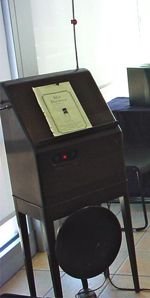 Eric Ross’s Composing For the Theremin is an interesting and concise article that reviews the unique challenges and opportunities of writing music for the theremin:
Eric Ross’s Composing For the Theremin is an interesting and concise article that reviews the unique challenges and opportunities of writing music for the theremin:
To write for the theremin effectively one should know its strengths and weaknesses.
The theremin is a monophonic instrument; which is to say, it can only produce one pitch at a time. It has about a five-and-a-half octave range. Its low range can sound like a cello or string bass, mid range to upper range can be vocal-like and the top end is brilliant and piercing. But with effects or MIDI you can extend both the range and timbre of the instrument.
Theremins work on the principle of heterodyning—that is, mixing the output of two radio frequency oscillators to produce a beat. When this frequency is over 50 Hz or so, an audio signal is produced which is then amplified.
The theremin is played by changing the alternating magnetic fields that surround two antennae. The resultant waveform is variable. One hand controls pitch, the other volume.
The theremin is difficult to play well. There’s no keyboard or fret board for reference. Spatial perception is only part of it. One must have a good ear, since ear training certainly helps in hitting the intervals correctly. It’s important to be relaxed physically and concentrated mentally to hear the note before it is played. You’ll need to make the right adjustments instantaneously to hit the note cleanly in the center of the pitch. There are several different styles and finger work that can be used to do this. Some players concentrate on the right hand which produces pitch, but the left hand which controls the volume and attack is equally important. In a way, the right hand is the artisan and the left hand is the artist.
See the full article at the New Music Box site.
via MusicOfsound, Image: Usonian
